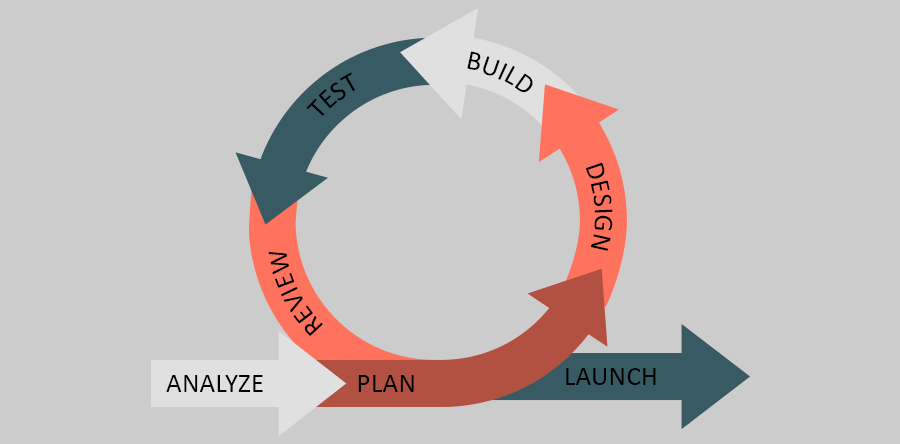The secret behind the working structure of most of the current successful tech companies’ working structures lies in the fact they all use Agile software development. Pumping up to find the reasons behind the greatness of Agile methodologies? Of course, due to its flexibility and evolutionary nature. End of the debate!
Now, more than just the flexible and evolutionary nature behind Agile software development, there are many things that we need to explain to you. This will take you to dive deep into agile methodology & agile software development methodology. So without any further ado, let’s get started!
Meaning of Agile
“Agility is catching fire,” according to management consulting company McKinsey & Company, as firms see the importance of the Agile methodology in a new era of work. The 21st century’s fast technology improvements have dominated the entire working scene, affecting every industry. The fact is the ‘Agile’ word represents the adaptability & immediate response to change.
According to the statistics, the percentage of software developers worldwide who used agile development methodology ( Agile Software Development ) and continuous integration (CI) methods increased from 2015 to 2018, based on a survey of development experts.
In 2001, 17 tech engineers created the Agile Manifesto for Software Development, which became the foundation of Agile. They created four fundamental principles for agile project management with the purpose of building a better mobile app or web app:
Agile Software Development Company
10+
Years on the market
500+
Completed projects
300+
Satisfied customers
9/10
Clients are ready to recommend us
Choosing Individuals and Interactions over tools and processes
In Agile methodology, as software development is done by humans, the quality of their interaction is important. Though tools are a crucial element of software development, concentrating on cooperation, regardless of the tools used by the team, produces outstanding software.
Working software instead of comprehensive documentation
Documentation may be a valuable resource for users and coworkers. However, rather than extensive documentation, software development attempts to create software that provides greater advantages.
Lesser contact negotiations, more Customer collaboration
The agile software development team communicates with the respective customers quite frequently. The team of Agile software development would then understand what stakeholders desire through listening to and receiving input from them.
Following a proper plan
Changes are a fact of life in software development, and your software process should reflect this. A project strategy should be adaptable enough to adjust as circumstances dictate. This goes for Agile software development too.
Meaning of Agile Software Development
Agile software development refers to any development method that adheres to the Agile Manifesto’s ideas. Developers construct their software in incremental, quick cycles, rather than releasing it all at once towards the end, in accordance with their goals and principles.
It works by dividing down projects into little chunks of user functionality, prioritising them, and then delivering them in 2-4 cycles known as Sprints or Iterations. An entire development cycle is completed in a single Sprint (2-4 weeks). It consists of the following steps: analysis, design, coding, testing, and product release.
At the end of each Sprint, developers provide a functional software solution, and the client evaluates its performance. The lessons learnt throughout each Sprint are documented in retrospectives and applied in subsequent iterations.
Agile Software Development Benefits
We all have read that Agile software development is a collaborative and flexible way of completing a software project. Such a framework lets you move fast & give the response when needed. However, there are more benefits of agile software development than just this. Hence let’s check that out:
1. A Quicker Feedback Cycle
Sometimes, you give your best in building a website or a mobile application, but at the end of the day, you fail to live up to the expectations of clients. Then you waste some time thinking about what went wrong & how things could have been placed? In agile software development working style, you get feedback in each stage, giving you a better understanding of your project and eliminating the mistakes at the start of that stage only.
2. No Compromises on the quality of the product
Testing is an integral component of the project execution phase in Agile project management, which implies that the overall quality of the final product is higher. The client is still active in the development process and can request adjustments based on market realities. Because Agile is an iterative process, self-organising teams continue to learn and develop over time, and they continue to improve without stopping.
3. Proper Control
Due to project transparency, agile software development provides better control. Through modern reporting tools and procedures, quality is assured throughout the project’s implementation phase, and all stakeholders are involved in the process with daily progress updates.
4. Risk-Free
Risks are part of the software development process. It is definitely unavoidable. However, through agile software development, you can reduce the chances of risk as it focuses on small sprints and on continuous delivery. As small targets get done systematically, there is a very less chance of some higher risk.
5. Capturing Problems Easily
Due to regular check-ups and meetings, if there is any problem, the agile software development team wastes no time in rectifying it. Hence, it is quite clear that even the bigger problems get recognised easily without wasting enough time & the entire team works to rectify them down the line.

6. Quicker Changes
While the team must remain focused on delivering an agreed-upon subset of the product’s features throughout each iteration, there is a chance to continuously revise and reprioritise the whole product backlog. Backlog items that have been added or updated can be scheduled for the following iteration, allowing for changes to be implemented within a few weeks.
7. Flexibility
When Agile methodology is properly applied in a project team, it provides them with unprecedented flexibility. Teams work in shorter spurts, complemented by the product owner’s continual input and engagement. Changes in other project management approaches are typically time-consuming and costly.
Agile, on the other hand, breaks the project into small sprints that are both manageable and flexible enough to allow the team to adopt changes quickly. One of the primary reasons why dynamic firms want to employ Agile in their projects is its unrivaled adaptability.
8. Project Planning at its Best!
Planning a project entails gaining a thorough understanding of the complete endeavour from start to finish and utilising guidelines and expertise, rather than a little guesswork, to identify prospective important dates. It takes a bird’s-eye view of the project and then needs to adapt when the team gets to the intricacies.
With Agile, the planning team ( Agile Software Development ) can concentrate on the content of each sprint, allowing them to dig down into much more depth and have a better understanding of the scope before the project ever begins.
Then, as an Agile project proceeds, they’ll employ metrics that differ from the Waterfall technique to assist them in gauging continuing achievements and failures. Agile metrics provide the team with a really concrete sense of whether the project is on track, behind, or ahead of schedule, from the time it takes to complete tasks to the time required for future ones, how much backlog there is, and how much work is still left to do.
9. High Efficiency
What makes Agile more adaptive also makes it more efficient. At the end of each sprint, the team convenes to reflect on what went well and what didn’t and to plan for the next phase of the project. If there are any inefficiencies in the process, they will be documented at the conclusion of each sprint, helping the team to enhance their work in the future.
10. Predictability
Agile teams work in short time increments known as sprints. These set lengths (for example, two weeks) make it easy for project managers to assess team performance and allocate resources accordingly. Costs are often easier to anticipate for shorter time spans than for long-term projects, making the estimation process simpler.
11. Quicker ROI
Because Agile allows the product to reach the market faster, the software firm – or customer, if you’re generating software for someone else – can begin earning money on it far sooner than with traditional software development. Of course, there are unique issues to consider here.
`If you release a less feature-rich piece of software that acquires a bad reputation, it may actually harm its long-term profitability. Companies who need to see results quickly owing to serious financial issues, on the other hand, would surely profit the most from Agile breakthroughs.
12. Clients with Smiles
Our eighth major commercial advantage of Agile software development is the sum of all the things preceding it. Because Agile allows customers to feel more involved, have more input, get to market quicker, and start seeing a return on investment from a more appealing product sooner, they tend to be more satisfied with each step of the process and each useful software release.
Not only that, but because Agile projects are iterative, end-users frequently have the opportunity to provide input and feel as though they are being heard. Working Agile, regardless of where you are in the process, usually means working happier.
Disadvantages of Agile Methodology
Despite having some amazing benefits of Agile methodology, it also has certain disadvantages. We can say that the things followed in Agile are not for everyone sometimes. Keeping that in mind, let us discuss some disadvantages of Agile methodology:
1. Documentation Limit
The whole documentation process becomes less detailed. Wanna know the reason? Documentation occurs throughout an Agile project and is typical “just in time” for generating the output rather than from the start.
As a result, it may be difficult for a developer to understand the actual client’s needs. Team members might quickly become confused when progressing through project stages if there is no clearly stated plan or an established method to follow.
2. Question mark for long-term projects?
Finally, one of the most prevalent Agile issues arises when teams attempt to apply the technique to inappropriate projects. Agile iterations are meant to gradually create smaller deliverables, which is great for software development. This kind of fragmentation, however, would be incompatible with a long-term endeavour.
3. The time factor
Another thing to add to the list of Agile problems is time. Members of the team must arrange daily standup meetings, which might disturb their workflow. Furthermore, the Agile mindset necessitates ongoing cooperation between developers, testers, clients, and other project stakeholders.
4. Difficulties in Collaboration
Agile is intended to be a liberating practice. When used correctly, project teams are capable of self-organisation and cross-functionality. Agile, on the other hand, necessitates unending cooperation, more time, and a larger commitment.
Last Thoughts on Agile Software Development
Agile is a great technique for software development that benefits not only the development team but also the client in a number of crucial business ways. Agile enables project teams to deal with many of the most frequent project issues (such as cost, schedule predictability, and scope creep) more effectively. Agile achieves the same goals by rearranging the activities involved in custom software development in a leaner and more business-focused manner.
We hope you understood the importance and benefits of Agile software development. If you want a whole Agile-like development team for building your business website, do contact us today!

Mitesh Prajapati
Mitesh Prajapati is Co-founder of LogicRays Technologies; he is known for connecting people to power by serving his unique abilities in various technologies to help businesses grow to the next level. Running a leading Web & App development company is not the only thing he is best at; with this, he’s been serving his expertise in Mobile App Development since more than 5 years now. He covers main areas like Android, iOS, React Native, and Flutter, to all the businesses that need growth by offering the best to their clients.
Subscribe To Our
Newsletter
Know The Technology!
Sign up today!
